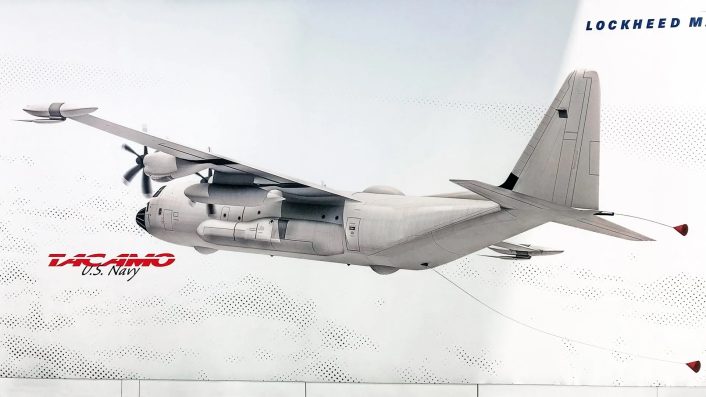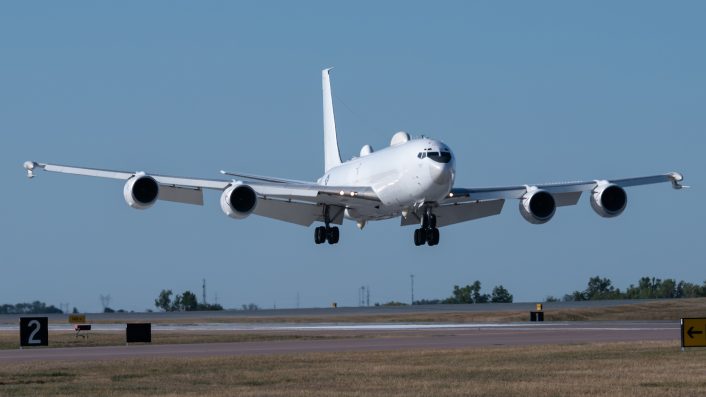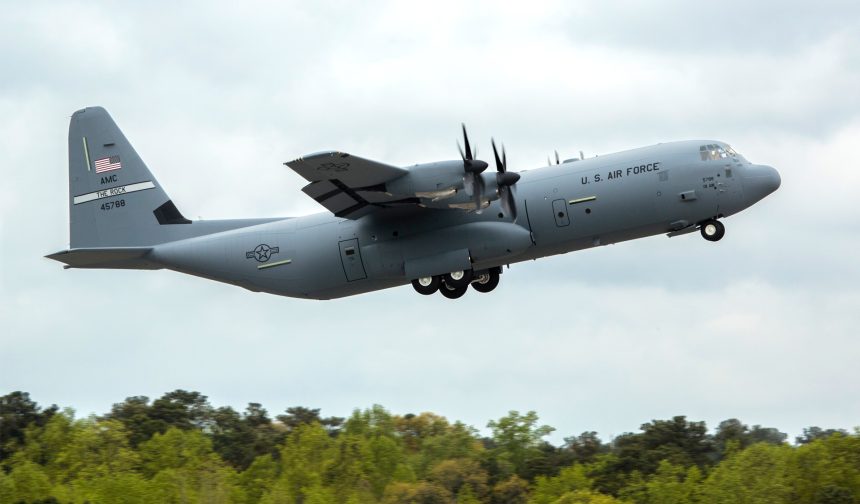The new E-130J TACAMO aircraft will be based on the C-130J-30 airframe with a number of modifications intended to host the mission equipment.
The U.S. Navy’s Airborne Strategic Command, Control and Communications Program Office (PMA-271) and Strategic Communications Wing 1 (SCW-1) announced on Oct. 21, 2024, the selection of the E-130J designation for the new Take Charge and Move Out (TACAMO) mission aircraft. Previously known as E-XX, the E-130J will be the successor of the current E-6B Mercury fleet.
“I am proud to announce that the U.S. Navy’s new TACAMO aircraft will be the E-130J,” said PMA-271 Program Manager Capt. Adam Scott. “This is an important milestone as we work toward delivering the next generation of TACAMO aircraft to the warfighter.”
The E-6B Mercury fleet, although it is derived from some of the last Boeing 707 airframes produced, is now in excess of thirty years old. The main role of the aircraft is to connect the President, Secretary of Defense and U.S. Strategic Command with naval ballistic missile forces, broadcasting radio transmissions in the very low frequency (VLF) range to communicate with submerged submarines.
The Navy said the U.S. Air Force approved the E-130J mission design series (MDS) this month, as the latter is in charge of the approval of the MDS for all military aircraft. The service further specified that the E stands for special electronic installation, 130 is the design number and J is the series, adding that the designation reflects the aircraft’s origins as the EC-130 and it will be modified from a proven C-130J-30 Super Hercules airframe. The common name, such as the Mercury of the outgoing TACAMO aircraft, has not yet been selected.
“I’m excited as SCW-1 continues to work together with PMA-271 to deliver new capabilities and strengthen America’s nuclear deterrence,” said SCW-1 Commander Capt. Britt Windeler. “The E-130J will assure that our nation’s leadership maintains control of its strategic forces as the E-6B gets closer to end of life, and enable it to focus on the performance of other critical missions until sundown.”

The E-130J
PMA-271 is procuring the E-130J through the TACAMO Recapitalization Program, whose most likely candidate was already considered to be the Super Hercules. Northrop Grumman, Lockheed Martin’s Skunk Works and Raytheon Intelligence and Space teamed up to bid for the program in 2023.
The solicitation, which closed in April 2024, is for a prime contractor to integrate TACAMO mission systems, including the Collins Aerospace Very Low Frequency (VLF) subsystem, into government-furnished C-130J-30 aircraft. The contract award is scheduled for January 2025, said NAVAIR in the press release.
The E-130J would become the 18th variant of the C-130 Hercules, according to a Lockheed Martin 2020 brochure which mentions that the Hercules already has 17 mission variants. However, the use of the type for the TACAMO mission is not a novelty, as the E-6B replaced another Hercules variant, the EC-130Q which was based on the C-130H.
Lockheed Martin already released in 2022 a concept for what it called the EC-130J, which included the trailing wires of the VLF antenna, enlarged and extended landing gear fairings, multiple domes extending both from the top and the bottom fuselage and fairings for other equipment on the wingtips. Back then, the first new aircraft was expected to arrive at NAS Patuxent River, Maryland, in Fiscal Year 2026.
Among the expected modifications are also electromagnetic pulse (EMP) hardening and cybersecurity hardening. Compared to the E-6B, however, the E-130J is not expected to Air Force’s Airborne Command Post (ABNCP) capability, which allows to communicate with the nuclear bombers and ICBM (InterContinental Ballistic Missiles) silos, as it will be reportedly integrated on the new Survivable Airborne Operations Center (SAOC) aircraft.

The E-6B Mercury
The E-6B Mercury, commonly known by many as the “Doomsday Plane“, plays an extremely important role for the U.S. National Security: they are used to relay instructions to the fleet ballistic missile submarines in case of nuclear war but also act as backups of the four E-4Bs NAOC (National Alternate Operations Center), working as ABNCP (Airborne Command Post) platforms.
Because of its sensitive mission, the Mercury is capable of communicating on virtually every radio frequency band, on commercial satellites and on the Internet, using also a secure VOIP system. The aircraft are often trackable online while performing various critical missions, flying orbits while trailing their antennas or exploiting a particular geostationary satellite for radio comms.
The transmissions from these antennas can be received using commercially available radio equipment but the messages themselves are transmitted in code, forming strings of letters and numbers called Emergency Action Messages (EAMs). These messages are similar to, and sometimes identical in terms of content, those transmitted on high frequency (HF) radio via the High Frequency Global Communications System (HFGCS).
Among the Mercury’s missions are the so-called Looking Glass mission (mirroring the ground-based C3 center at Offutt AFB and relaying orders); talking to submarines trailing a 26,000 ft wire antenna; launching commands to ICBMs (InterContinental Ballistic Missiles) via Airborne Launch Control System, and performing C3 (Command Control Communication) operations to forces operating in theater or to the U.S. strategic bombers flying Global Strike missions.
The U.S. Navy has a fleet of 16 E-6Bs operated by the Strategic Communications Wing 1 (SCW-1) squadrons home based out of Tinker Air Force Base, Oklahoma. They include the “Ironmen” of Fleet Air Reconnaissance Squadron (VQ) 3, “Shadows” of VQ-4 and “Roughnecks” of VQ-7.









